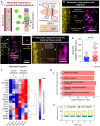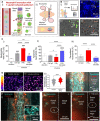Innate immune cell response to host-parasite interaction in a human intestinal tissue microphysiological system
- PMID: 35544643
- PMCID: PMC9075809
- DOI: 10.1126/sciadv.abm8012
Innate immune cell response to host-parasite interaction in a human intestinal tissue microphysiological system
Abstract
Protozoan parasites that infect humans are widespread and lead to varied clinical manifestations, including life-threatening illnesses in immunocompromised individuals. Animal models have provided insight into innate immunity against parasitic infections; however, species-specific differences and complexity of innate immune responses make translation to humans challenging. Thus, there is a need for in vitro systems that can elucidate mechanisms of immune control and parasite dissemination. We have developed a human microphysiological system of intestinal tissue to evaluate parasite-immune-specific interactions during infection, which integrates primary intestinal epithelial cells and immune cells to investigate the role of innate immune cells during epithelial infection by the protozoan parasite, Toxoplasma gondii, which affects billions of people worldwide. Our data indicate that epithelial infection by parasites stimulates a broad range of effector functions in neutrophils and natural killer cell-mediated cytokine production that play immunomodulatory roles, demonstrating the potential of our system for advancing the study of human-parasite interactions.
Figures






Similar articles
-
The Toxoplasma gondii effector GRA83 modulates the host's innate immune response to regulate parasite infection.mSphere. 2023 Oct 24;8(5):e0026323. doi: 10.1128/msphere.00263-23. Epub 2023 Sep 28. mSphere. 2023. PMID: 37768053 Free PMC article.
-
Mechanisms of Human Innate Immune Evasion by Toxoplasma gondii.Front Cell Infect Microbiol. 2019 Apr 16;9:103. doi: 10.3389/fcimb.2019.00103. eCollection 2019. Front Cell Infect Microbiol. 2019. PMID: 31041194 Free PMC article. Review.
-
Human innate immunity to Toxoplasma gondii is mediated by host caspase-1 and ASC and parasite GRA15.mBio. 2013 Jul 9;4(4):e00255-13. doi: 10.1128/mBio.00255-13. mBio. 2013. PMID: 23839215 Free PMC article.
-
Toxoplasma gondii GRA28 Is Required for Placenta-Specific Induction of the Regulatory Chemokine CCL22 in Human and Mouse.mBio. 2021 Dec 21;12(6):e0159121. doi: 10.1128/mBio.01591-21. Epub 2021 Nov 16. mBio. 2021. PMID: 34781732 Free PMC article.
-
Vaccination as a control strategy against the coccidial parasites Eimeria, Toxoplasma and Neospora.Parasitology. 2006;133 Suppl:S145-68. doi: 10.1017/S0031182006001855. Parasitology. 2006. PMID: 17274844 Review.
Cited by
-
Unraveling the Microbiome-Human Body Axis: A Comprehensive Examination of Therapeutic Strategies, Interactions and Implications.Int J Mol Sci. 2024 May 20;25(10):5561. doi: 10.3390/ijms25105561. Int J Mol Sci. 2024. PMID: 38791599 Free PMC article. Review.
-
Modeling lung endothelial dysfunction in sepsis-associated ARDS using a microphysiological system.Physiol Rep. 2024 Jul;12(13):e16134. doi: 10.14814/phy2.16134. Physiol Rep. 2024. PMID: 38981846 Free PMC article.
-
Advancing intestinal disease research using gut-on-a-chip.Regen Ther. 2025 May 6;29:541-550. doi: 10.1016/j.reth.2025.04.023. eCollection 2025 Jun. Regen Ther. 2025. PMID: 40475693 Free PMC article. Review.
-
Synovial fibroblasts support vascular function in an acute injury-on-a-chip model.bioRxiv [Preprint]. 2025 Jul 17:2025.07.12.664530. doi: 10.1101/2025.07.12.664530. bioRxiv. 2025. PMID: 40791345 Free PMC article. Preprint.
-
Engineered Vasculature for Cancer Research and Regenerative Medicine.Micromachines (Basel). 2023 Apr 29;14(5):978. doi: 10.3390/mi14050978. Micromachines (Basel). 2023. PMID: 37241602 Free PMC article. Review.
References
-
- Buzoni-Gatel D., Schulthess J., Menard L. C., Kasper L. H., Mucosal defences against orally acquired protozoan parasites, emphasis on Toxoplasma gondii infections. Cell. Microbiol. 8, 535–544 (2006). - PubMed
-
- Mestas J., Hughes C. C. W., Of mice and not men: Differences between mouse and human immunology. J. Immunol. 172, 2731–2738 (2004). - PubMed
MeSH terms
Grants and funding
LinkOut - more resources
Full Text Sources

